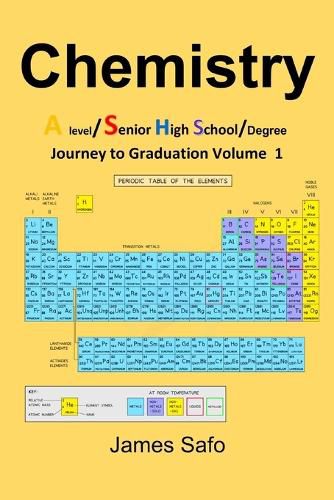Readings Newsletter
Become a Readings Member to make your shopping experience even easier.
Sign in or sign up for free!
You’re not far away from qualifying for FREE standard shipping within Australia
You’ve qualified for FREE standard shipping within Australia
The cart is loading…






This book is about four hundred pages and covers most of the "A" lever or SHS ( Senior High School) syllabi. Chemistry is the science that studies substances' properties, atomic composition, and structure, characterised as elements and compounds, the transformations they undergo, and the energy released or absorbed during these processes. It also involves varied interactions among substances, leading to sudden, frequently vicious reactions. Chemistry also is concerned with the utilisation of natural substances and the creation of artificial ones. Examples of chemical processes include cooking, fermentation metallurgy or glass making. The five main areas of chemistry are organic, inorganic, analytical, physical, and biochemistry. Organic chemistry involves the study of carbon and its compounds, especially those related to life. Organic compounds are based on the chemistry of carbon. Inorganic chemistry deals with non-carbon compounds, often metals and minerals. Analytical chemistry focuses on the identification and measurement of chemical substances. Physical chemistry studies the physical properties and behaviour of molecules and reactions. Physical chemistry seeks to measure, correlate, and explain the quantitative aspects of chemical processes. Biochemistry is the chemistry of living organisms and their processes However; sometimes biochemistry is considered a subdiscipline of organic chemistry1. Biochemists employ chemistry techniques and theories to probe life's molecular basis. Photochemistry is a speciality that investigates the interaction of light with matter. The branches of chemistry overlap with those of physics and biology There are also many sub-branches and types of chemistry shared with other disciplines Most natural materials on Earth, such as wood, coal, minerals, or air, are mixtures of many different and distinct chemical substances. Each pure chemical substance (e.g., oxygen, iron, or water) has a characteristic set of properties that gives it its chemical identity. Iron, for example, is a common silver-white metal that melts at 1,535 degrees C, is very flexible, and immediately combines with oxygen to form the common hematite and magnetite. Industrial Chemistry Industrial Chemists include manufacturing, inspecting, and safely handling chemical products, product development, and general management.
$9.00 standard shipping within Australia
FREE standard shipping within Australia for orders over $100.00
Express & International shipping calculated at checkout
This book is about four hundred pages and covers most of the "A" lever or SHS ( Senior High School) syllabi. Chemistry is the science that studies substances' properties, atomic composition, and structure, characterised as elements and compounds, the transformations they undergo, and the energy released or absorbed during these processes. It also involves varied interactions among substances, leading to sudden, frequently vicious reactions. Chemistry also is concerned with the utilisation of natural substances and the creation of artificial ones. Examples of chemical processes include cooking, fermentation metallurgy or glass making. The five main areas of chemistry are organic, inorganic, analytical, physical, and biochemistry. Organic chemistry involves the study of carbon and its compounds, especially those related to life. Organic compounds are based on the chemistry of carbon. Inorganic chemistry deals with non-carbon compounds, often metals and minerals. Analytical chemistry focuses on the identification and measurement of chemical substances. Physical chemistry studies the physical properties and behaviour of molecules and reactions. Physical chemistry seeks to measure, correlate, and explain the quantitative aspects of chemical processes. Biochemistry is the chemistry of living organisms and their processes However; sometimes biochemistry is considered a subdiscipline of organic chemistry1. Biochemists employ chemistry techniques and theories to probe life's molecular basis. Photochemistry is a speciality that investigates the interaction of light with matter. The branches of chemistry overlap with those of physics and biology There are also many sub-branches and types of chemistry shared with other disciplines Most natural materials on Earth, such as wood, coal, minerals, or air, are mixtures of many different and distinct chemical substances. Each pure chemical substance (e.g., oxygen, iron, or water) has a characteristic set of properties that gives it its chemical identity. Iron, for example, is a common silver-white metal that melts at 1,535 degrees C, is very flexible, and immediately combines with oxygen to form the common hematite and magnetite. Industrial Chemistry Industrial Chemists include manufacturing, inspecting, and safely handling chemical products, product development, and general management.